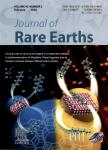Luminescence properties of near-UV excitable yellow-orange light emitting warm CaSrAl_2SiO_7:Sm^(3+) phosphors
Luminescence properties of near-UV excitable yellow-orange light emitting warm CaSrAl_2SiO_7:Sm^(3+) phosphors作者机构:School of Studies in Physics and Astrophysics Pt.Ravishankar Shukla University Center for Nanoscience and NanotechnologyPt.Ravishankar Shukla University
出 版 物:《Journal of Rare Earths》 (稀土学报(英文版))
年 卷 期:2019年第37卷第4期
页 面:365-373页
核心收录:
学科分类:081702[工学-化学工艺] 08[工学] 0817[工学-化学工程与技术] 0803[工学-光学工程]
主 题:Thermoluminescence Photoluminescence Aluminosilicate Yellow-orange emitting phosphor Samarium CaSrAl2SiO7:Sm3+
摘 要:Single-phase CaSrAl_2 SiO_7:Sm^(3+) phosphors were synthesized by traditional high temperature solid state reaction method. Formation of samples and phase analysis were confirmed by X-ray diffraction technique. Morphology was done by field emission scanning electron microscopy and elemental compositions were confirmed by energy dispersive X-ray analysis. Present phosphors have tetragonal crystallography with space group P42_1 m. Average crystallite size was calculated by using Scherrer and Williamson-Hall method. Photoluminescence study of CaSrAl_2 SiO_7:Sm^(3+) phosphor was *** different excitation wavelengths, PL spectra consist of four emission bands at 564, 570, 601 and650 nm. The emission bands located at 564 and 570 nm are associated with the transition ~4 G_(5/2)→~6 H_(5/2)while emission bands at 601 and 650 nm are due to ~4 G_(5/2)→~6 H_(7/2) and ~4 G_(5/2)→~6 H_(9/2),*** emission was obtained when phosphor was excited under 404 nm wavelength. Non-radiative energy transfer process involved in concentration quenching, was also discussed. CIE coordinate is found in yellow-orange region, hence CaSrAl_2SiO_7:Sm^(3+) phosphors emit yellow-orange light when efficiently excited by near UV(~400 nm) LED chip. Color purity and CCT of the phosphor were determined; CCT suggests that present phosphor is a good candidate as a warm yellow-orange color emitting phosphor. Effect of different heating rates and different UV exposure time on the TL glow curve of the phosphor was investigated. Activation energies and kinetic parameters for different traps were calculated by using peak shape method. TL emission spectrum was also recorded. Present article explains all the possible mechanisms associated with luminescence process in CaSrAl_2 SiO_7:Sm^(3+) phosphors.




